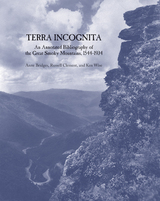
For anyone who has yet to discover the beauty of the Smokies, the highest North American mountains east of the Mississippi, the trails described here offer a splendid introduction. Scenic overlooks at Mount Le Conte, Clingmans Dome, Gregory Bald, and other peaks are included along these pathways, as are some of the well-known waterfalls of the Park, such as Laurel Falls, Rainbow Falls, and Ramsay Cascades. In addition to vital data about the length of the trail, its elevation gain, and “how to get there,” each trail description is packed with interesting facts and Smoky Mountain lore. Detailed maps are also included. In their introduction, the authors provide a brief overview of the park’s history as well as useful tips for novice hikers.
The Authors: Kenneth Wise, an administrator at the University of Tennessee Library, Knoxville, has hiked in the Great Smoky Mountains National Park for more than twenty years. He is the author of <i>Hiking Trails of the Great Smoky Mountains: A Comprehensive Guide</i>.
James Andrews,a partner in the firm of Andrews, Hudson & Wall, P.C., has hiked the Park trails for more than a decade. He is the coauthor, with Wise, of <i>The Best Overnight Hikes in the Great Smoky Mountains</i>.

Kenneth Wise and James Andrews
Located astride the Tennessee–North Carolina border, the Great Smoky Mountains National Park contains more than one hundred trails that trace eight hundred miles of rugged terrain. This fact is certain to bewilder any newcomer who might be eager to explore the Park’s backcountry but is unsure where to start. This book, intended as a beginner’s guide to hiking the Smokies, offers lively, informative descriptions of twenty-two trails that can be completed in a day or less.
For anyone who has yet to discover the beauty of the Smokies, the highest North American mountains east of the Mississippi, the trails described here offer a splendid introduction. Scenic overlooks at Mount Le Conte, Clingmans Dome, Gregory Bald, and other peaks are included along these pathways, as are some of the well-known waterfalls of the Park, such as Laurel Falls, Rainbow Falls, and Ramsay Cascades. In addition to vital data about the length of the trail, its elevation gain, and “how to get there,” each trail description is packed with interesting facts and Smoky Mountain lore. Detailed maps are also included. In their introduction, the authors provide a brief overview of the park’s history as well as useful tips for novice hikers.
The Authors: Kenneth Wise, an administrator at the University of Tennessee Library, Knoxville, has hiked in the Great Smoky Mountains National Park for more than twenty years. He is the author of Hiking Trails of the Great Smoky Mountains: A Comprehensive Guide.
James Andrews,a partner in the firm of Andrews, Hudson & Wall, P.C., has hiked the Park trails for more than a decade. He is the coauthor, with Wise, of The Best Overnight Hikes in the Great Smoky Mountains.


breathtaking and rugged national parks. The second edition of this compellingly readable
and useful book is completely updated, giving outdoor enthusiasts the most current
information they need to explore this world-renowned wilderness.
Included here are facts on more than 125 official trails recognized by the Park Service.
Each one has its own setting, purpose, style, and theme, and author Kenneth Wise
describes them in rich and vivid detail. For every route, he includes a set of driving directions
to the trailhead, major points of interest, a schedule of distances to each one, a
comprehensive outline of the trail’s course, specifics about where it begins and ends, references
to the U.S. Geological Survey’s quadrangle maps, and, when available, historical
anecdotes relating to the trail. His colorful descriptions of the area’s awe-inspiring beauty
are sure to captivate even armchair travelers.
Organized by sections that roughly correspond to the seventeen major watersheds
in the Smokies, Wise starts in Tennessee and moves south into North Carolina, with
two major trails—the Lakeshore and the Appalachian—that traverse several watersheds
treated independently. Further enhancing the utility of this volume is the inclusion of the
Great Smoky Mountains’ official trail map as well as an informative introduction filled
with details about the geology, climate, vegetation, wildlife, human history, and environmental
concerns of the region.
A seasoned outdoorsman with more than thirty years of experience in the area and
codirector of the Great Smoky Mountains Regional Project at the University of Tennessee,
Knoxville, Wise brings an exceptional depth of knowledge to this guide. Both experienced
hikers and novices will find this newly revised edition an invaluable resource for trekking in
the splendor of the Smokies.

Aircraft Crashes in the Great Smoky Mountains National Park, 1920–2000
Jeff Wadley and Dwight McCarter
Since the dawn of aviation, more than fifty aircraft have crashed in the Great Smoky Mountains. This book details all of those known incidents from 1920 to 2000, including those that occurred within the area before the establishment of the National Park in 1934. Jeff Wadley and Dwight McCarter, who have been involved in search-and-rescue missions in the Smokies for decades, have researched official documents and newspaper archives and conducted extensive interviews with survivors, family members, and eyewitnesses to record not only tragedies but also triumphs of survival.
The authors tell how the earliest known plane crashes in the Smokies were of the single-engine Curtis "Jenny" biplanes flown by young air aces during the World War I era. In the years since, the Smokies have claimed private planes, military jets, helicopters, and even a hot air balloon. These disasters arose from numerous causes—from fuel depletion and icing to "dare-deviling" or simply flying too low. Wadley and McCarter attest to the difficult duties of search-and-rescue teams in the most remote areas of the park. Of 127 persons involved in crashes, only 56 survived. Readers will be touched by these accounts—such as that of two small children who survived a December 1977 crash that killed their father and older sister.
Mayday! Mayday! offers both cautionary tales for pilots who fly above these ridges and seasoned advice to those who search for victims. The Smokies have been called by some another Bermuda Triangle; this book explains why and reminds us that no skies are entirely friendly.
The Authors: Jeff Wadley is a lieutenant colonel in the Tennessee Civil Air Patrol who serves as a mission coordinator and trainer in the Smokies.
Dwight McCarter served as a backcountry ranger in the park for over twenty years and is the author of Lost! A Ranger's Journal of Search and Rescue in the Great Smoky Mountains National Park.

“It is a seminal work and is ‘must reading’ for anyone seriously interested in the early interpretation of the Great Smoky Mountains.”—Arthur McDade, author of The Natural Arches of the Big South Fork
First published in a limited edition in 1975 by the author’s widow and now available in paperback for the first time, Out Under the Sky of the Great Smokies brings together the personal journals of a great environmentalist and nature writer.
The book combines descriptions of Broome’s innumerable hikes in the Great Smoky Mountains with extended meditations on the meaning of the mountains to the region as a whole. It is at once a historical document, preserving a perspective on the Smokies before full-scale development of the national park, and a work whose message about the importance of the environment is even more timely today than when it first appeared.
In a foreword written especially for this edition, the noted environmental writer Michael Frome describes the book as “a timeless work,” adding, “Here we find Harvey, the wilderness apostle on his home turf. He reveals himself exactly as I knew and loved him: a gentle spirit, sensitive to the needs of nature and humankind, always with tolerance and good humor.”
The Author: Harvey Broome (1902–1968) was born in Knoxville, Tennessee, and discovered the Great Smoky Mountain at an early age. An attorney, he helped found the Wilderness Society and served as president of the Smoky Mountains Hiking Club. He was the author of two other posthumously published books, Faces of the Wilderness and Harvey Broome: Earth Man.

Born in Bryson City, North Carolina, Jim Casada has had a long career as a teacher, author, and avid outdoorsman. He grew up in a time and place where families depended on the land and their community to survive. Many of the Smoky Mountain customs and practices that Casada reflects on are gradually disappearing or have vanished from our collective memories.
In A Smoky Mountain Boyhood, Casada pairs his gift for storytelling and his training as a historian to produce a highly readable memoir of mountain life in East Tennessee and western North Carolina. His stories evoke a strong sense of place and reflect richly on the traits that make the people of Southern Appalachia a unique American demographic. Casada discusses traditional folkways; hunting, growing, preparing, and eating wide varieties of food available in the mountain region; and the overall fabric of mountain life. Divided into four main sections—High Country Holiday Tales and Traditions; Seasons of the Smokies; Tools, Toys, and Boyhood Treasures; and Precious Memories—each part reflects on a unique and memorable coming-of-age in the Smokies.
Containing a strong sense of adventure, nostalgic tone, and well-paced prose, Casada’s memoir will be appreciated by those who yearn to rediscover the Smokies of their childhoods as well as those who wish to imaginatively climb these mountains for the first time.

Frome's recent conversations with residents, new and old, along with a complement of historic and contemporary photographs, confirm the views stated in the book's original 1966 edition.
The author brings his knowledge, experience, and insights to bear on "one of God's special places." He suggests alternatives to commercial overdevelopment and the destruction of the Great Smokies' flora and fauna, citing recent cases such as the Tellico Dam project and the continuing pollution of the Pigeon River. Always emphasizing our inevitable relationship with our surroundings, Frome relates the story of the Great Smoky Mountains with respect and affection for the region, its people, and their history.
Michael Frome ranks among the foremost American authors on travel and conservation. His interests are closely associated with national parks, national forests, and natural beauty in the United States and other countries. He has been a columnist and correspondent for major newspapers and magazines and a university lecturer. He is author of Conscience of a Conservationist: Selected Essays.

Starting with the de Soto map of 1544, the earliest document that purports to describe anything about the Great Smoky Mountains, and continuing through 1934 with the establishment of the Great Smoky Mountains National Park—today the most visited national park in the United States—this volume catalogs books, periodical and journal articles, selected newspaper reports, government publications, dissertations, and theses published during that period.
This bibliography treats the Great Smoky Mountain Region in western North Carolina and east Tennessee systematically and extensively in its full historic and social context. Prefatory material includes a timeline of the Great Smoky Mountains and a list of suggested readings on the era covered. The book is divided into thirteen thematic chapters, each featuring an introductory essay that discusses the nature and value of the materials in that section. Following each overview is an annotated bibliography that includes full citation information and a bibliographic description of each entry.
Chapters cover the history of the area; the Cherokee in the Great Smoky Mountains; the national forest movement and the formation of the national park; life in the locality; Horace Kephart, perhaps the most important chronicler to document the mountains and their inhabitants; natural resources; early travel; music; literature; early exploration and science; maps; and recreation and tourism. Sure to become a standard resource on this rich and vital region, Terra Incognita is an essential acquisition for all academic and public libraries and a boundless resource for researchers and students of the region.

Based on years of research, the diaries, memoirs, literature, and journalism collected here shed light on various historical and cultural aspects of the Great Smokies, from Smoky Mountain folkways and religion, to the Civil War era and the Cherokee Indians. All together, the writings pay tribute to the diverse inhabitants of the Great Smoky Mountains.
Each section gathers writings under a single topic heading and progresses chronologically. The readings can thus be taken to document the slow progression of change up until the eve of the large-scale disruptions that would be wrought by the establishment of the Great Smoky Mountains National Park in 1934. This reader represents a significant contribution to scholarship on the Smokies and the region at large.

“Carson Brewer at his absolute best.” – Sam Venable
Carson Brewer on…
Mountain places
Snow was nice and crunchy underfoot. Not crunchy like peanuts or cornflakes. Rather, it was a silky whispery crunchy.
Mountain plants
You can bury your nose deep in the cool violet bed and smell the mix of life and death while pondering the unceasing cycle of each into the other.
Mountain People
Lem Ownby…has plowed oxen, mules, and horses on the forty-four acre farm on Jakes Creek. But he has never owned or driven an automobile.
The Author: Carson Brewer was a reporter and columnist for more than forty years. His columns on conservation issues and on the Great Smoky Mountains earned him the E.J. Meeman Conservation Award (twice) from the Scripps-Howard Foundation, the Golden Press Card award from the Society of Professional Journalists (which also named a scholarship in his honor in 1984), and the inaugural Lifetime Achievement Award from the Knoxville Writers Guild. He died on January 15, 2003.
READERS
Browse our collection.
PUBLISHERS
See BiblioVault's publisher services.
STUDENT SERVICES
Files for college accessibility offices.
UChicago Accessibility Resources
home | accessibility | search | about | contact us
BiblioVault ® 2001 - 2024
The University of Chicago Press









